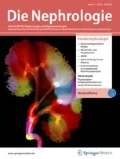Zusammenfassung
Die autosomal-dominante polyzystische Nierenerkrankung („autosomal dominant polycystic kidney disease“, ADPKD) ist die häufigste genetische Nierenerkrankung, sie betrifft weltweit etwa 6 Mio. Menschen. Die Erkrankung ist durch eine progressive Entwicklung unzähliger Nierenzysten charakterisiert, die das normale Nierengewebe sukzessive verdrängen, was letztlich zum Verlust der Nierenfunktion ab der vierten Lebensdekade führen kann. Aktuell gibt es keine kausale Therapie, welche die Progression verlangsamen oder stoppen würde. In Tiermodellen wurde eine Vielzahl potenzieller Therapien getestet: Vasopressinrezeptor-2-Antagonisten (VPV2RA), mTOR („mammalian target of rapamycin“)-Inhibitoren, Somatostatin und -analoga sowie Inhibitoren von CFTR, B-Raf, MEK, Src, Tumornekrosefaktor-α und Cyclinen. In klinischen Studien wird derzeit die Wirksamkeit von VPV2RA, mTORi, Somatostatinanaloga und Renin-Angiotensin-Aldosteron-Inhibitoren getestet. Es besteht Hoffnung, dass diese schwere Erkrankung künftig kausal therapiert werden kann.
Abstract
Autosomal dominant polycystic kidney disease (ADPKD) is the most prevalent human genetic kidney disease, affecting about 6 million people worldwide. It is characterized by progressive development of innumerable renal cysts that gradually replace normal kidney tissue, leading ultimately to the loss of renal function starting from the fourth decade of life. There is currently no causal therapy that slows or stops ADPKD progression. In animal models of polycystic kidney disease, a variety of potential therapies have been tested: vasopressin receptor-2 antagonists (VPV2RA), mammalian target of rapamycin inhibitors (mTORi), somatostatin and its analogs, inhibitors of CFTR, B-Raf, MEK, Src, tumor necrosis factor alpha, and cyclins. Currently the efficacy of VPV2RA, mTORi, somatostatin analogs, and inhibitors of the renin angiotensin aldosterone system is being clinically tested. It is hoped that this serious disease can be treated causally in the coming years.

Literatur
Cadnapaphornchai MA, Mcfann K, Strain JD et al (2009) Prospective change in renal volume and function in children with ADPKD. Clin J Am Soc Nephrol 4:820–829
Caroli A, Antiga L, Cafaro M et al (2010) Reducing polycystic liver volume in ADPKD: Effects of somatostatin analogue octreotide. Clin J Am Soc Nephrol 783–789
Chapman AB, Johnson A, Gabow PA et al (1990) The renin-angiotensin-aldosterone system and autosomal dominant polycystic kidney disease. N Engl J Med 323:1091–1096
Ecder T, Chapman AB, Brosnahan GM et al (2000) Effect of antihypertensive therapy on renal function and urinary albumin excretion in hypertensive patients with autosomal dominant polycystic kidney disease. Am J Kidney Dis 35:427–432
Ecder T, Edelstein CL, Fick-Brosnahan GM et al (2001) Diuretics versus angiotensin-converting enzyme inhibitors in autosomal dominant polycystic kidney disease. Am J Nephrol 21:98–103
Gattone VH Ii, Chen NX, Sinders RM et al (2009) Calcimimetic inhibits late-stage cyst growth in ADPKD. J Am Soc Nephrol 20:1527–1532
Grantham JJ, Cook LT, Wetzel LH et al (2010) Evidence of extraordinary growth in the progressive enlargement of renal cysts. Clin J Am Soc Nephrol
Grantham JJ, Torres VE, Chapman AB et al (2006) Volume progression in polycystic kidney disease. N Engl J Med 354:2122–2130
Hogan MC, Masyuk TV, Page LJ et al (n d) Randomized clinical trial of long-acting somatostatin for autosomal dominant polycystic kidney and liver disease. J Am Soc Nephrol
Inoki K, Corradetti MN, Guan KL (2005) Dysregulation of the TSC-mTOR pathway in human disease. Nat Genet 37:19–24
Masyuk TV, Masyuk AI, Torres VE et al (2007) Octreotide inhibits hepatic cystogenesis in a rodent model of polycystic liver disease by reducing cholangiocyte adenosine 3’,5’-cyclic monophosphate. Gastroenterology 132:1104–1116
Morice MC, Serruys PW, Sousa JE et al (2002) A randomized comparison of a sirolimus-eluting stent with a standard stent for coronary revascularization. N Engl J Med 346:1773–1780
Nagao S, Nishii K, Katsuyama M et al (2006) Increased water intake decreases progression of polycystic kidney disease in the PCK rat. J Am Soc Nephrol 17:2220–2227
Nagao S, Nishii K, Yoshihara D et al (2008) Calcium channel inhibition accelerates polycystic kidney disease progression in the Cy/+ rat. Kidney Int 73:269–277
Ruggenenti P, Remuzzi A, Ondei P et al (2005) Safety and efficacy of long-acting somatostatin treatment in autosomal-dominant polycystic kidney disease. Kidney Int 68:206–216
Serra AL, Poster D, Kistler AD et al (2010) Sirolimus and kidney growth in autosomal dominant poycystic kidney disease. N Engl J Med 0907419
Shillingford JM, Murcia NS, Larson CH et al (2006) From the cover: The mTOR pathway is regulated by polycystin-1, and its inhibition reverses renal cystogenesis in polycystic kidney disease. Proc Natl Acad Sci U S A 103:5466–5471
Shillingford JM, Piontek KB, Germino GG et al (2010) Rapamycin ameliorates PKD resulting from conditional inactivation of Pkd1. J Am Soc Nephrol 21:489–497
Stallone G, Schena A, Infante B et al (2005) Sirolimus for Kaposi’s sarcoma in renal-transplant recipients. N Engl J Med 352:1317–1323
Torres VE, Bankir L, Grantham JJ (2009) A case for water in the treatment of polycystic kidney disease. Clin J Am Soc Nephrol 4:1140–1150
Torres VE, Harris PC (2006) Mechanisms of disease: autosomal dominant and recessive polycystic kidney diseases. Nat Clin Pract Nephrol 2:40–55
Torres VE, Harris PC, Pirson Y (2007) Autosomal dominant polycystic kidney disease. Lancet 369:1287–1301
Torres VE, Wang X, Qian Q et al (2004) Effective treatment of an orthologous model of autosomal dominant polycystic kidney disease. Nat Med 10:363–364
Van Dijk MA, Breuning MH, Duiser R et al (2003) No effect of enalapril on progression in autosomal dominant polycystic kidney disease. Nephrol Dial Transplant 18:2314–2320
Van Keimpema L, Nevens F, Vanslembrouck R et al (2009) Lanreotide reduces the volume of polycystic liver: a randomized, double-blind, placebo-controlled trial. Gastroenterology 137:1661–1668 e1661–e1662
Wahl PR, Serra AL, Le Hir M et al (2006) Inhibition of mTOR with sirolimus slows disease progression in Han:SPRD rats with autosomal dominant polycystic kidney disease (ADPKD). Nephrol Dial Transplant 21:598–604
Walz G, Budde K, Mannaa M et al (2010) Everolimus in patients with autosomal dominant polycystic kidney disease. N Engl J Med
Harris, Torres (2009) Polycystic kidney disease. Annu Rev Med 60:321–337
Interessenkonflikt
Der korrespondierende Autor gibt an, dass kein Interessenkonflikt besteht.
Author information
Authors and Affiliations
Corresponding author
Rights and permissions
About this article
Cite this article
Serra, A., Poster, D. & Wüthrich, R. Autosomal-dominante polyzystische Nierenerkrankung. Nephrologe 5, 404–411 (2010). https://doi.org/10.1007/s11560-010-0421-6
Published:
Issue Date:
DOI: https://doi.org/10.1007/s11560-010-0421-6
Schlüsselwörter
- Autosomal-dominante polyzystische Nierenerkrankung
- „Mammalian target of rapamycin“-Inhibitoren
- Somatostatin
- Vasopressinrezeptor-2-Antagonisten

